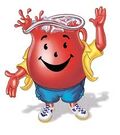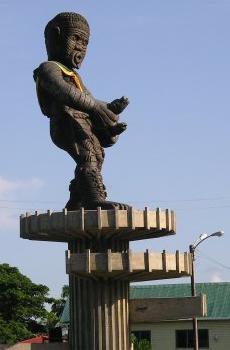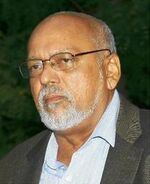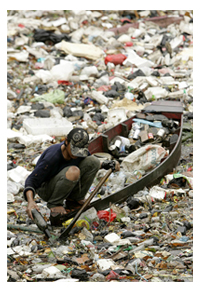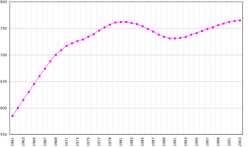Guyana
Guyana | |||||
|---|---|---|---|---|---|
| |||||
| Motto: Feed Me Now | |||||
| Anthem: Food, Glorious Food (from the musical Oliver!) | |||||
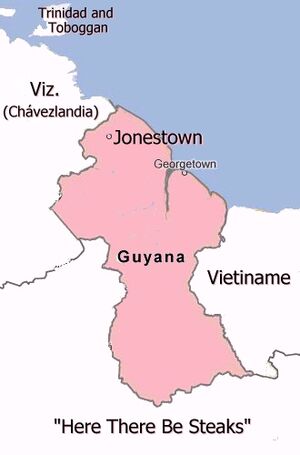 | |||||
| Capital | Jonestown | ||||
| Largest city | New York City and Miami | ||||
| Official language(s) | Pidgin English with colorful local expressions. | ||||
| National hero(es) | Cuffy, Cheddi, Fluffy, and Scruffy. | ||||
| Declaration of Independence |
No; still dependent on cocaine. | ||||
| Religion | Charismatic evangelism with rituals involving cyanide. | ||||
| Major exports | House pets and toddlers painted to resemble exotic animals. | ||||
| Major imports | All its food. | ||||
Guyana is a unique country on the North coast of South America. It is the only "Caribbean" island not on an island, and the only nation in the vicinity that claims to speak English. The nation has an otherworldly ambience, mostly owing to the total impossibility of legal extradition. "What happens in Guyana, stays in Guyana," as the tourist slogan puts it, and this includes the vast majority of the corpses.
Guyana achieved independence from the United Kingdom in 1966 and became a republic in 1970, embarking on a national path resembling that of a depth charge launched from a destroyer. The nation has been on a mission to show the rest of the world that throwing off white colonialism in favor of local self-government solves every problem, except perhaps imminent starvation.
History
Guyana was originally a territory of Britain, but only because everyone was doing it (owning South American colonies). During this time, it was called British Guiana. The nation is situated between Dutch Guiana (now called Suriname) and Caramel Creme Nougat Guiana (now the island of Toboggan).
Upon independence, Guyana changed the spelling of its name, just to throw people off the track. Fatefully, this disrupted the last of the pizza deliveries.
Slavery was outlawed in Guyana in...well, it has been illegal for a very long time. The freed slaves were joined by slaves who were freed somewhere else, and by slaves who had not been freed somewhere else. They were often slaves in the first place because of their skin color, and many believed that they would have something in common with other Guyanese. They were right, but it wasn't skin color. The immigrants from Africa, India, the Mideast, and penguins from Antartica promptly set upon one another.
Incipient race war
The Indo-Guyanese and Afro-Guyanese never got the upper hand over one another--though they did barbecue all the penguins--and peace was achieved by a Unity government based on a charismatic leader named Cuffy and a President named Cheddi. (This means that you would only need a Tinky and a Balph to have a complete set of villains for an Ayn Rand novel.)
Cheddi, however, was a self-declared Marxist who wanted to turn Guyana into a Marxist state, "unaligned," like they all are, yeah, sure. In retrospect, the only reason Cuffy was not a self-declared Marxist too is that the declaration did not exist, as Marx had not yet been born.
The United States opposed Cheddi in favor of Forbes Burnham, who came from money, surely, with a name like that. (This is back when the United States was fighting the destabilization of countries rather than personifying it.)
Ultimately, the United States prevailed, and Guyana began imitating it. In other words, Cheddi's wife took over.
Just add water
Apart from its bronze medal in sit-ups at the 1952 Olympics, the only historical event that has ever earned Guyana international notice occurred in 1978 at the Peoples Temple in Jonestown, organized by charismatic televangelist Jim Jones. Jones, by remarkable coincidence, was also a self-described Marxist, who envisaged Jonestown as the first Soviet satellite not in Earth orbit. The Peoples Temple selected Guyana for its base after disagreements with American officials involving the use of torture and the non-use of apostrophes. The commune had plans to open branches in Siberia and Pyongyang.
What put Jonestown on the map was when Jones convinced his congregation--almost all imported from the United States because of their unique aptitude for the role of naïve disciple--to substitute Kool-Aid for the ceremonial wine at communion. This was not as fateful as the concurrent decision to substitute cyanide for the wafers. Jones referred to the resulting "revolutionary suicide" as an act of revenge against the CIA agents who were scheming to shut them down. Guess that showed them.
A total of 909 parishioners, including Jones himself, perished in this ceremony (the others had to be tracked down and shot), making their entry into the Guinness Book of World Records a certainty in the mass-suicide category, except that all were unable to sign the verifying documents required by that meticulous agency.
The day was as bad a day for organized religion as it was for powdered drink mixes. But happily, new generations of "Kool-Aid drinkers" have sprung up and act with the total credulity that made the Peoples Temple famous. Likewise, in-country, the principal subject of political discussion remains whether it is more expedient to perform ritual revolutionary suicide individually, as pioneered at Jonestown, or together as a nation.
Grain drain
"Feed Me Now!" remains the motto of Guyana, as it has been since Cuffy's time, and the several government programs that guarantee free food are raging successes, marred only by the chronic exodus of Guyanese to feed, notably led by anyone who knows how to grow food.
Coinage in the past has featured hopeful mottoes such as "Rice Harvest" or "Sugar Cane," not because either is imminent but mostly just to get people to attach value to the money. A seven-sided coin invited citizens to pretend they were (still) British, and recent coinage has shifted to motivational phrases, including "Self-Determination," "Endurance," and most recently, "Quit Yer Bitching."
Law and politics
Guyana's government is a representative republic with multiple political parties. Separation of powers exists between Marxist insurgents and the Army death squads. Legislative power is vested in the National Assembly (here not referring to the country's signature bread lines). Further independence is achieved by having the judicial branch live abroad for the personal safety of the judges.
Under the Constitution of Guyana, the President is both Head of State and head of government, and is usually head of the drug cartel. Under the constitution, the President can dissolve the Assembly and call for new elections. In contrast, there is no way for the Assembly to dissolve the President, nor even to recommend that he bathe. This is cited with hope as a structural similarity to Switzerland. It relieves Guyana of having to invent reasons why a constitutional term limit on the President is never enforced against the current guy.
The National Assembly was reformed in 2001, and was declared "free and fair" by American gadabout Jimmy Carter, to dispel any remaining doubt. It is therefore at least as democratic as Venezuela. Now, 25 members are elected to represent regions, while 40 are elected on a national basis to represent skin colors. Election Day is a national holiday, and armed troops patrol the streets to give added confidence that the government will follow the popular will.
Geography
The geography of Guyana is described as a mountainous, lush paradise; as "a jungle with deadly disease" might discourage tourism. The Northwest of Guyana appears on maps of Venezuela as a part of the national territory labeled Area In Reclamation (reclamación), which is more than Guyana would do with it, if Guyana had maps.
Guyana's muggy weather is broken up by trade winds along the coast, hopefully named as though there were trade. The Wikipedia article is downright giddy that Guyana's rain forest is virtually inaccessible, wistfully adding a hope that the coastal cities would be equally inaccessible. In fact, poaching is a problem in the national preserves, so much so that Government poaches animals from neighboring Suriname, and brings them in to Guyana to be poached, by short-order cooks. Indeed, poaching causes an influx to the rain forest of Guyanese who think that eggs are being served. The illegal animal trade has risen to such proportions that city-dwellers frequently paint their pigs, chicken, and children to resemble jaguars and achieve a quick sale. Three-quarters of Guyana's native bird species are found only in the lobby of the Jonestown Hilton.
However, much of Guyana remains covered in green, mostly in the shade of the reverse of the U.S. $1 bill. The Southwest is desert savannah, where the prevalent cactus is harvested despite not being hallucinogenic, as it is a key source of toothpicks.
Carnivorous parrots inhabit the lowland and often swoop down and snatch tourist buses. This is probably the reason that most buses now carry rocket launchers.
Demographics
The population of Guyana is 752,000 and counting--down. Hundreds of thousands are in the United States, either awaiting formal residency papers, having residency in hand, or not worrying about residency at all. The graph shows the population through 2003, the last year the government took a census. This was done by making the census form resemble a menu, and as dinner did not follow, the population is unlikely to cooperate again.
There is a gathering movement to make Guyana the 51st state of the United States. The sponsoring organization, GuyanaUSA, believes it is more expedient to break into the United States collectively than individually. The group's web site claims that half the population of Guyana is either already in the United States or is halfway up the border fence.
Culture
Guyana's official language is English, though broken English is as predominant as broken intercity buses. Both are marked by much cursing and swearing. This is usually the key to distinguishing the Guyanese from tourists, until the tourists try to get either room service or good food.
Guyana's distinctive art style is on display on the main road from the International Airport to Jonestown. These works blend bright colour and rhinestones with classical elements in order to promote a foreign brand of cigarette. A clever billboard painter finds a thematic use for each bullet hole.
Sport
The British brought cricket to the island for a relaxing alternative to raping and pillaging. Famous local cricketers include:
- Clive Lloyd, who won awards as the black man with the most British-sounding name ever.
- Carl Hooper, a baseball player notorious for hitting nothing but grounders and for throwing pitches that bounced in front of the plate. He found cricket especially forgiving in those respects.
- Shivarine Chanderpaul, who revolutionised the sport in the 1990s by wearing adhesive tape under his eyes and by building an actual brick wall in front of his wicket.
Porgie Murda is Guyana's most famous sportsman. He led the national selection to victory over arch-rival Suriname in 1985. A year later he led them to Florida in an unsuccessful attempt to defect en masse. Murda retired from sport in 1976 to embark on a short-lived television career, as he was able to get only one season for his knock-off prime-time show, Dial M for Murda.
| ||||||||
| Featured version: 14 November 2012 | |
| This article has been featured on the main page. — You can vote for or nominate your favourite articles at Uncyclopedia:VFH. | |

